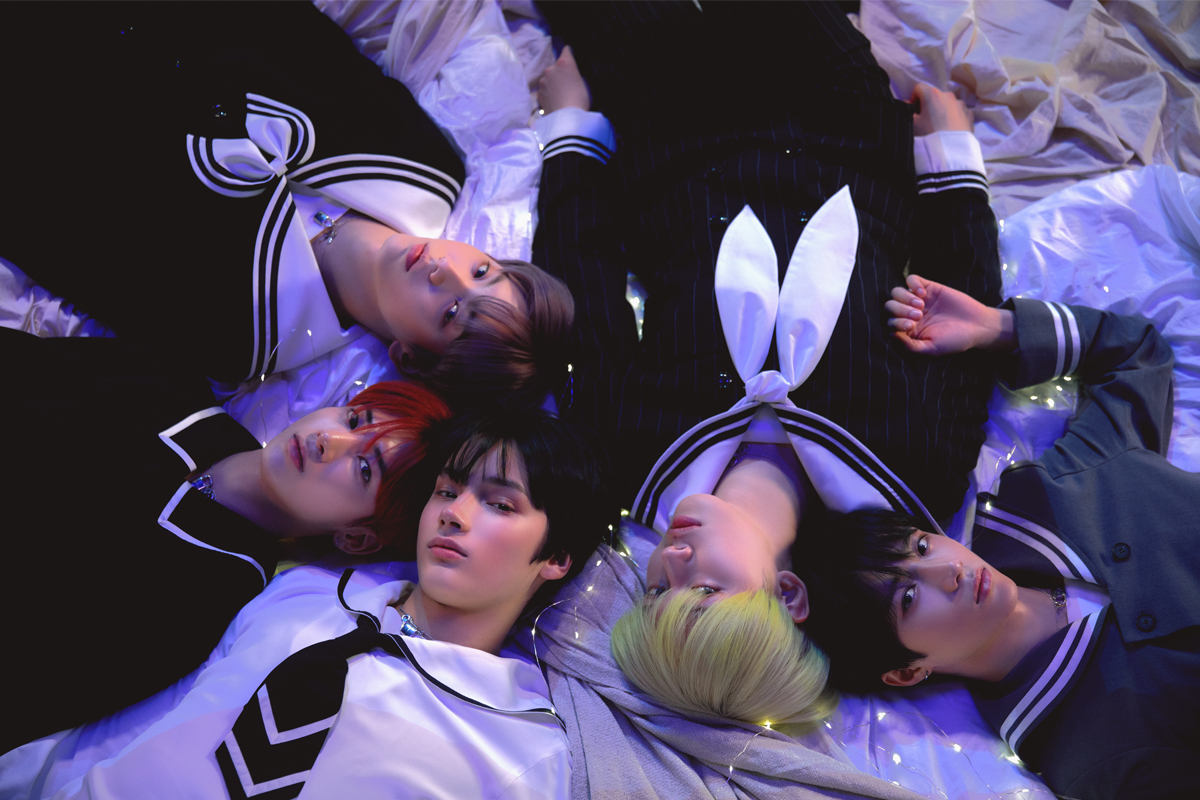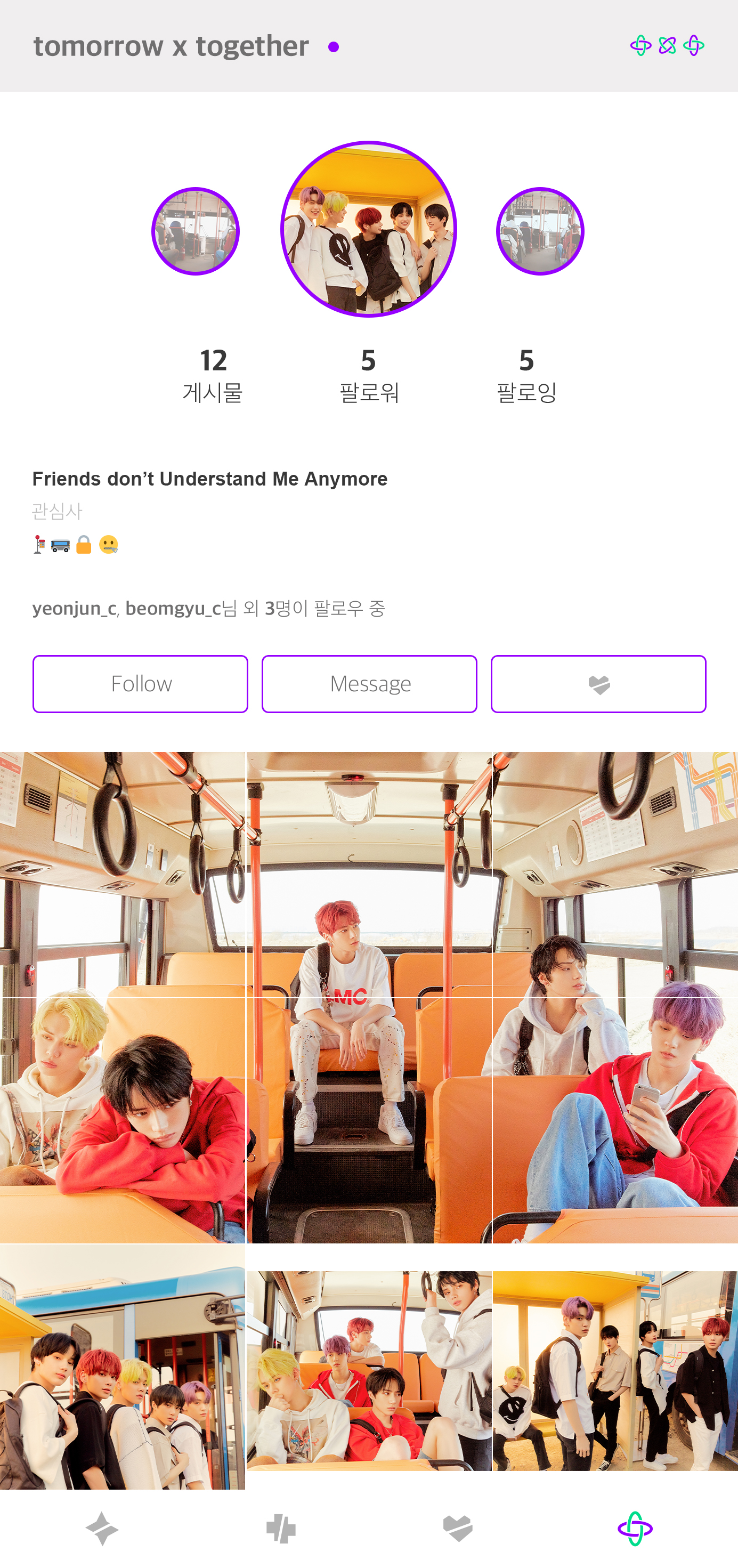
REVIEW
TOMORROW X TOGETHER, Microhistory of Youth
An overview of TOMORROW X TOGETHER before their comeback
2020.10.05
Boy group TOMORROW X TOGETHER's album,
, is not a story of eternity, unlike its title. Rather, the album focuses on a fissure caused by the reality that cannot last forever. The teaser video of "Drama" visualizes SOOBIN's feelings of alienation among his friends through a table that gradually grows to widen the gap between the members. In the music video of the title track "Can't You See Me?", the members of TOMORROW X TOGETHER encounter the reality of their relationship with friends going sour after eating a red fruit that seems to symbolize the fruit of good and evil. The youth stand on the border of reality that runs between the beautiful past and the distorted reality. It is symbolic that the album jacket of
was designed with five pieces that originally seemed to be one. In "PUMA" the desire to be reborn as an independent self is depicted, while in the track TOMORROW X TOGETHER’s members participated in the production "Maze in the Mirror" that reveals them to be agonizing about identity. In "The Shampoo Fairy," a remake of Light and Salt’s classic, it is revealed by the speaker's perspective that the ideal symbolized by "her" is recognized to exist only on TV. In "Eternally", the inner confusion that wanders between the borders of dreams and reality is expressed. In one album, there are various feelings on relationships that intersect, such as skepticism, longing, and desire and concern about selfness. In short, the songs in
are the result of tracking down the various particles of emotions that the youth experience within them during the process of growth.
The crack was predetermined. The title track of TOMORROW X TOGETHER's debut album
, "CROWN," visually emphasized the innocent pureness of teenage boys. However, the lyrics of the song compare the confused inner side of puberty of not being understood by the older generation to the motifs of "horn" and "monster." This consciousness leads to an escape towards a virtual reality with rules different from the established world, such as "Can't We Just Leave the Monster Alive” and "Run Away”. The aforementioned symbols of the rift adds contextual clues to the conflict dealt in the third album,
. The encounter of egos with unique inner sides like "monsters" leads to conflict, revealing an aspect of reality that cannot be masked by hypothetical escapes. The "Dream Chapter" series has gradually developed its narrative by placing elements in each album that show the self-conflict and identity concerns experienced by teenagers during their growth process. As a result, the fragmentary emotional cracks in
contrasts with the previous albums that were pure or fairytale, and also convincingly unravels the context on why these changes appear. The first three albums since TOMORROW X TOGETHER's debut independently deal with various aspects of teenagers, but in a connected narrative; it is also a process of teenagers becoming aware of themselves, perceiving the boundaries between themselves and the world and looking for a place to escape, and encountering their fragile inner selves in the "world that has burned down". In the process of the clarification of the boundary between self and the world after puberty, the complex inner side of teenagers, which appeared only to be bright, is now expressed in a multitude of directions.
The crack was predetermined. The title track of TOMORROW X TOGETHER's debut album
-
 © BIGHIT MUSIC
© BIGHIT MUSIC
It is no coincidence that the concept photo of
focuses on the individual feelings experienced by teenagers as fissures develop in relationships and interactions. In the concept photo "Port," which is organized in the form of an Instagram feed, the members are sitting on a bus together, but each of them has a profound look on their faces. Phrases such as, "There is someone who broke our relationships" and, "We were all together at the time, right?" attached to each member’s personal feed focus on the individuals’ feelings caused by these divides. Expressing the various emotions that teenagers experience due to conflicts through each song in the album is the concept that penetrates
. The song "Drama" compares the feeling of alienation and doubt in a teenage relationship to the relationship between a "drama," "the main character," and "the supporting role." The basic beat of "Drama" is cheerful, but the melody mainly focuses on the speaker's anxiety of not being able to be the main character in the relationship as the melody gradually descends instead of forming a sense of catharsis. "PUMA" puts forward the concept of intuitively comparing the desire of teenagers to escape from the established world to animals, but it also serves as a means to express the circular feelings of youth who have begun to face reality outside the fairy tale world.
In short,
is the result of decisions on each song's concept, which contains various inner experiences of youth in a rite of passage to reality. The melody of "Can't You See Me?" repeats its descent instead of creating a climax, and as they sing "Crumbled sand castle/Who's a liar" a combination of sounds like the electronic sounds that resemble the sounds of explosives surrounds the vocals, creating an image of a dark and unstable space. As a result, the thrilling beat sentiment based on whistling turns into a grudge against the world that does not pay attention to itself.
consistently embodies every element of the gaze toward the self and the world through the inner side of a teenager including the visual concept and sound design. In 1996, H.O.T's debut album, which spoke of school violence experienced by teenagers, was titled 'We Hate All Kinds of Violence.' On the other hand,
is a huge discourse that puts the most personal feelings of youth at the center of its content instead of dealing with teenagers’ stories. Eventually, these micro-personal stories become a more profound understanding of the times now experienced by teenagers. This is the moment in which the microhistory of youth is placed in the core of K-pop.
In short,
From their underdog roots, BTS has become stars that today represent minority and diversity across the world. On the other hand, the world of TOMORROW X TOGETHER, who made their debut at the same agency after BTS' success, seemed to have already been completed as their start had been. A predecessor group had already become global stars, and the label had grown massively to match their stature. That is why it seemed difficult to find deficiencies in their narrative. However, BEOMGYU said in an interview with Billboard last May 12 about the song "Maze in the Mirror" which all TOMORROW X TOGETHER members participated in production; he said this song was based on his own experience. "When I practice singing and dancing, I start to see others in my reflection in the mirror." TOMORROW X TOGETHER, composed of five young people in their late teens and early 20s, is on a journey of agonizing over their identity as many people do. It is also a universal concern that they cannot avoid even if they are stars loved by their fans. Through three albums, TOMORROW X TOGETHER reveals the world of current teenagers in a different way than BTS, and
shows the most various and the deepest innermost aspects of all the youth among the three albums.
Notwithstanding detractors who accuse idols of being the carefully-planned product of big capital,
offers a new direction for the authentic embodiment of the spirit of teens today by an idol group. It is about the inner wanderings of youth in this low-growth era, where everything seems to have been completed, but actually a time not easy to attain new opportunities. Just as TOMORROW X TOGETHER’s members, sometimes seen as hailing from a "silver spoon" agency by the press, reveal their concerns about self through their self-composed song "Maze in the Mirror," showing that the youth of this era embodies their own darkness that the older generation is ignorant of. Thus emerged the microhistory of youth that all had been aware of but no one had chosen to focus on.
Notwithstanding detractors who accuse idols of being the carefully-planned product of big capital,
Article. Rieun Kim
Copyright © Weverse Magazine. All rights reserved.
Unauthorized reproduction and distribution prohibited.
Unauthorized reproduction and distribution prohibited.